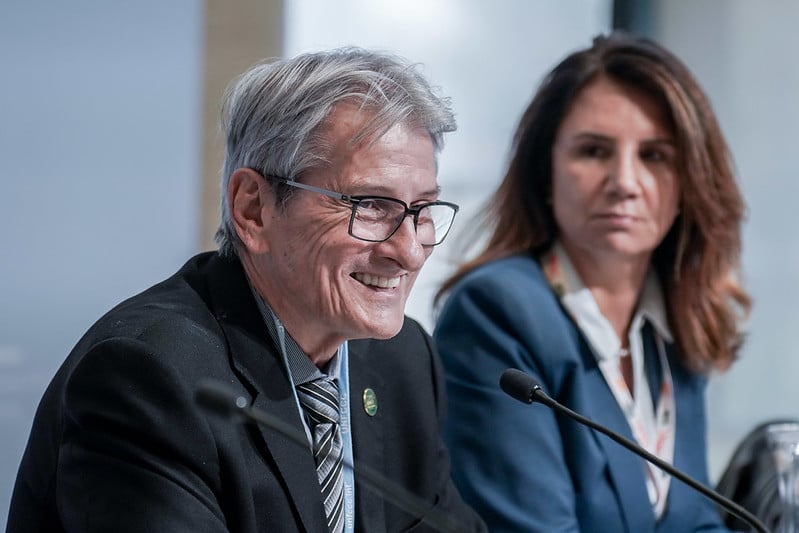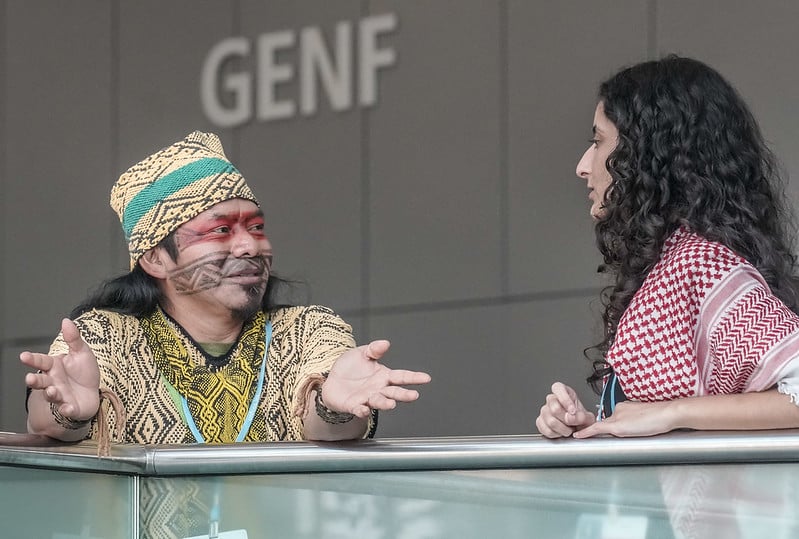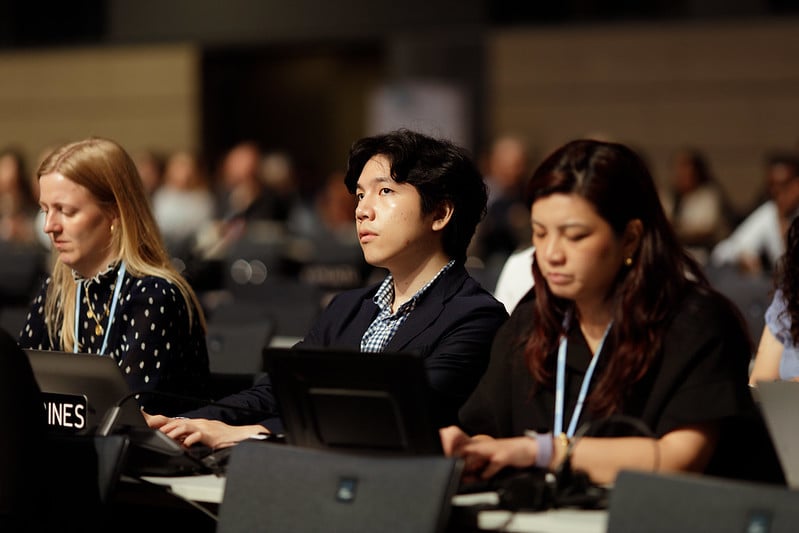
Mutirão and Identity – the Social Architecture of Global Cooperation

Part 1: Overview – Psychology of COPs
Part 2: Trust
Part 3: Emotions
Part 4: Psychological Safety
Part 5: Mutirão and Identity
Part 6: Empathy between Worlds
Part 7: coming soon
Anyone who has ever sat in the negotiation halls of a UN Climate Conference can feel it instantly: the invisible tension between us and them. Between the Global South and the Global North. Between small island states and major emitters. Between youth activism and state diplomacy.
These dividing lines are not only political – they are psychological.
Climate diplomacy is, at its core, a form of identity politics. It touches on belonging, recognition, and collective self-understanding. Collective decisions – especially those concerning the climate crisis – are always expressions of social identity. People act not only as individuals but as members of groups, nations, and alliances. These affiliations provide meaning and orientation – and they shape whom we listen to, whom we trust, and with whom we feel connected.
Why Identity Can Divide – and Also Unite Diplomacy
Identity can build walls – or bridges.
It becomes a barrier when it reinforces difference, fuels mistrust, and obscures what is shared. Yet it can also become the psychological infrastructure of cooperation when re-narrated not as opposition, but as a collective story of action.
This is where the Brazilian concept of “Mutirão” offers profound insight: a spirit of community action grounded in diversity, solidarity, and shared responsibility.
Social identity is the engine of collective efficacy – it determines whether people experience themselves as part of a movement capable of change.
In a world where the climate crisis follows the fault lines of power and inequality, Mutirão opens a new horizon: a we defined not by nation or status, but by the shared conviction that transformation is only possible together.
Where Identity Operates
Identity shapes climate diplomacy on every level – visible and invisible. It determines who is heard, who is trusted, and whose reality counts.
Five arenas reveal its particular force:
-
Between regions and states: The long-standing North–South divide continues to shape expectations, mistrust, and power relations – as well as differing resources and self-images.
-
Within delegations and alliances: Background, age, gender, and institutional role influence who speaks – and who is listened to.
-
In facilitation and moderation: Language, gestures, and values create – or prevent – spaces of shared identity.
-
In narratives, symbols, and rituals: Stories, songs, and gestures of solidarity foster belonging beyond political texts.
-
In moments of genuine cooperation: When delegates say “We made progress together,” they experience collective agency – the psychological foundation of multilateral effectiveness.
Scientific Background – The Psychology of Identity and Collective Efficacy
- Social identity describes the part of our self that stems from group membership – imbued with emotional meaning and shared norms and goals (Tajfel & Turner, 1979). When social identity becomes salient, the focus shifts from I to we – and with it, from individual to collective motivation.
- Collective efficacy (Bandura, 2006) is the shared belief in a group’s capacity to achieve results through joint action. It counters helplessness and strengthens agency – especially in crises no single actor can solve alone.
- Collective identity arises when people not only belong to a group but experience themselves as a community in action, united through shared experiences, emotions, and purposes.
- Narrative identity (McAdams, 2013) highlights how the stories we tell about “who we are” and “what we stand for” give coherence and direction – shaping behavior and cooperation.
In multilateral arenas such as the COPs, these psychological foundations are essential: only when delegates experience themselves as part of a shared “we” – a global Mutirão – can diversity become a source of collective power.




Observations from the Negotiation Rooms
At SB62 in Bonn, identity dynamics were palpable.
Among the small island states, there was a remarkable cohesion and sense of mutual support – particularly within the Pacific, where shared history, vulnerability, and ambition bind nations together. The spatial layout itself mirrored belonging: SIDS delegates sitting side by side, EU representatives facing them across the aisle. Identity was literally mapped into the room.
The Brazilian concept of “Mutirão,” introduced early by the COP30 Presidency, captures this spirit of collective action rooted in Indigenous Brazilian traditions. Yet in Bonn it remained more an idea than a practice. The negotiations stayed text-focused; human encounters were rare. Stories from frontline communities found little space.
Outside the formal rooms, however, something shifted.
Over coffee, dinner, or a beer after long sessions, titles and roles fell away. Delegates from the Pacific and the EU – who by day could not agree on language – laughed together, exchanged stories, and spoke of home.
Beyond protocol, the essence of Mutirão came to life: connection through shared humanity – solidarity not as a tactic, but as lived experience.
Psychological Dynamics and Pitfalls
Identity is powerful – and fragile. It can connect or divide, depending on whether it functions as a bridge or a shield. In high-stakes diplomacy marked by hierarchy, history, and uncertainty, it becomes a psychological fault line.
- Intergroup thinking: When groups see each other as adversaries, information is filtered through identity. Arguments from an outgroup are dismissed, regardless of quality (Fielding & Hornsey, 2016; Fritsche et al., 2018).
- Identity threat: When political measures or narratives challenge a group’s continuity or efficacy, defensive reactions arise – from denial to disengagement (Barnett et al., 2021; Jaspal, Nerlich & Cinnirella, 2014).
- False unity: Overstating sameness (“We’re all the same”) can mask inequalities and erode trust. Effective cooperation requires acknowledging difference – dual identity rather than one-group identity (Fielding & Hornsey, 2016; Rosenmann, Reese & Cameron, 2016).
- Emotional dynamics: Collective emotions – pride, anger, shame, guilt – can either energize or paralyze action. Empathy, shared dignity, and joint purpose transform them into cohesion (Brosch, 2025; Van Zomeren, Postmes & Spears, 2008).
- Narrative distortion: When identities are defined solely in opposition (“we, the affected” vs. “they, the responsible”), division deepens. Narratives of shared responsibility reopen pathways for collaboration (Brosch, 2025; Fritsche et al., 2018; Hamann et al., 2025).
In short: collective identity is not a harmonious ideal but a continuous negotiation between belonging, distinctiveness, and dignity.
What the Research Shows
Empirical studies on social identity and collective efficacy converge on a clear insight: a shared sense of “we” is the strongest psychological predictor of collective action – stronger than emotion, knowledge, or incentives.
- Collective efficacy: Groups convinced of their joint capacity act with greater determination, coordination, and resilience – even under pressure (Bandura, 2006, 2018).
- Social identity as driver: Meta-analyses reveal that identification with a group consistently predicts engagement and solidarity in collective climate action (Agostini & Van Zomeren, 2021; Van Zomeren, Postmes & Spears, 2008).
- Dual identity and justice: Cooperation thrives when actors maintain both their specific identity and an overarching belonging – for instance, as Pacific nations and part of a global community (Fielding & Hornsey, 2016; Rosenmann, Reese & Cameron, 2016).
- Emotion and morality: Collective emotions like empathy, guilt, or pride mediate between identity and action. Shared moral narratives foster responsibility rather than defensiveness (Brosch, 2025; Van Zomeren, Postmes & Spears, 2008).
- Experiencing shared agency: Tangible experiences of cooperation – from AOSIS team spirit to informal alliances – strengthen trust, optimism, and long-term commitment (Bamberg, Rees & Schulte, 2018; Hamann et al., 2025).
For climate diplomacy, this means: where people experience themselves as part of a shared “we,” collective agency emerges – the psychological foundation of any Mutirão culture.
Ways Forward – How Collective Identity and Agency Grow
What does this mean in practice? How can delegations, presidencies, and facilitation teams create spaces where a shared “we” becomes tangible – where a genuine Mutirão can take shape?
1. Create Mutirão spaces:
Dialogue formats where delegates, activists, and community representatives think and act together foster shared reality and empathy. Facilitation becomes a catalyst of collective identity.
2. Tell stories of efficacy:
Shift narratives from deficit to possibility – from “too little progress” to “acts of courage and connection.” Stories of Mutirão remind us that change is already underway.
3. Enable shared experiences of agency:
Co-design projects, regional alliances, and practical collaboration cultivate collective efficacy – the sense that individual efforts matter within a greater whole.
4. Facilitate dual identity:
Good facilitation honors both belonging and difference. Framing cooperation as “Pacific and global,” for example, sustains trust and respect.
5. Make progress visible:
Recognize small wins and alliances. Visible success stabilizes belief in collective impact.
6. Use rituals, symbols, and joy:
Shared rituals – check-ins, reflection rounds, celebrations – strengthen cohesion and emotional energy. Joy itself is a social glue for collective resilience.
Collective identity cannot be decreed – but it can be designed: through spaces, language, and gestures that nurture trust and agency.
Conclusion – Mutirão as the Identity of Cooperation
Mutirão is more than collaboration – it is a psychological paradigm of shared responsibility and mutual empowerment.
When diplomacy ceases to be a competition of interests and becomes a collective process of shared agency, its inner structure transforms – from negotiation to co-creation, from mistrust to mutual accountability.
A Mutirão COP means that delegates, communities, and institutions experience themselves as parts of one living system – not despite their differences, but through them.
Seen this way, climate diplomacy becomes a practice of psychological cooperation: people recognizing one another as allies in each other’s agency.
Further Reading
- Agostini, M., & Van Zomeren, M. (2021). Toward a comprehensive and potentially cross-cultural model of why people engage in collective action: A quantitative research synthesis of four motivations and structural constraints. Psychological bulletin, 147(7), 667.
- Bamberg, S., Rees, J. H., & Schulte, M. (2018). Environmental protection through societal change: What psychology knows about collective climate action—and what it needs to find out. In Psychology and climate change (pp. 185-213). Academic Press.
- Bandura, A. (2006). Toward a psychology of human agency. Perspectives on psychological science, 1(2), 164-180.
- Bandura, A. (2018). Toward a psychology of human agency: Pathways and reflections. Perspectives on psychological science, 13(2), 130-136.
- Barnett, J., Graham, S., Quinn, T., Adger, W. N., & Butler, C. (2021). Three ways social identity shapes climate change adaptation. Environmental research letters, 16(12), 124029.
- Brosch, T. (2025). From individual to collective climate emotions and actions: a review. Current Opinion in Behavioral Sciences, 61, 101466.
- Fielding, K. S., & Hornsey, M. J. (2016). A social identity analysis of climate change and environmental attitudes and behaviors: Insights and opportunities. Frontiers in psychology, 7, 121.
- Fritsche, I., Barth, M., Jugert, P., Masson, T., & Reese, G. (2018). A social identity model of pro-environmental action (SIMPEA). Psychological review, 125(2), 245.
- Hamann, K., Junge, E., Blumenschein, P., Dasch, S., Wernke, A., & Bleh, J. (2025). The Psychology of Collective Climate Action: Building Climate Courage. Taylor & Francis.
- Jaspal, R., Nerlich, B., & Cinnirella, M. (2014). Human responses to climate change: Social representation, identity and socio-psychological action. Environmental Communication, 8(1), 110-130.
- Rosenmann, A., Reese, G., & Cameron, J. E. (2016). Social identities in a globalized world: Challenges and opportunities for collective action. Perspectives on psychological science, 11(2), 202-221.
- Van Zomeren, M., Postmes, T., & Spears, R. (2008). Toward an integrative social identity model of collective action: a quantitative research synthesis of three socio-psychological perspectives. Psychological bulletin, 134(4), 504.
About the Author
Janna Hoppmann is a psychologist and Mercator Fellow for International Affairs. She has worked for many years at the intersection of psychology, climate, and politics – including with governments of SIDS states, international NGOs, and currently in close exchange with the COP30 Presidency. With ClimateMind, she brings psychological insights into international climate negotiations, into the work of delegations, and into transformative dialogue formats.
👉 If you would like to strengthen your delegation, alliance, or organization at COP30 or beyond – for example through trust-building, resilience training, or strategies for storytelling and collective efficacy – feel free to reach out via email.
Questions or thoughts? Feel free to get in touch – or stay connected with us through our newsletter, online academy, and community.


